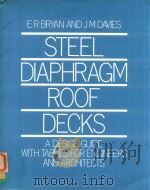《MANUAL OF STRESSED SKIN DIAPHRAGM DESIGN》
| 作者 | J.M.DAVIES AND E.R.BRYAN 编者 |
|---|---|
| 出版 | GRANADA |
| 参考页数 | 441 |
| 出版时间 | 1982(求助前请核对) 目录预览 |
| ISBN号 | 0246114843 — 求助条款 |
| PDF编号 | 83353958(仅供预览,未存储实际文件) |
| 求助格式 | 扫描PDF(若分多册发行,每次仅能受理1册) |

Contents1
Preface1
PART Ⅰ DESIGN METHOD AND EXAMPLES1
Introduction1
1.1 Historical background3
1.2 The present situation3
1.3 Principles of diaphragm action6
1.4 Types of building suitable for stressed skin design7
1.7 Necessary conditions for stressed skin action8
1.6 Suitable fasteners for stressed skin design8
1.5 Suitable cladding for stressed skin action8
1.8 Loading and load factors10
1.9 Economic advantages of stressed skin design10
1.10 Other types of stressed skin structure12
The basic shear panel17
2.1 Basic arrangements and definitions17
2.2 Types of diaphragm17
2.3 Components of an individual panel17
2.4 Determination of flexibility and strength21
2.5 Fastener characteristics21
2.7 Expressions for diaphragm strength(cantilever panel,sheeting perpendicular to span)24
2.6 Principles and assumptions in design expressions24
2.8 Expressions for diaphragm flexibility(cantilever panel,sheeting perpendicular to span)33
2.9 Modification to design expressions for sheeting spanning parallel to span of diaphragm38
2.10 Welded diaphragms40
2.11 Aluminium diaphra41
2.12 Effect ofbonded insulat42
2.13 Diaphragms in the vertical plane42
Design of panel assembli43
3.1 Assemblies of panels to form a complete diaphragm43
3.3 Design expressions for complete diaphrag45
3.2 Roofs of irregular plan45
3.4 Modifications to design expressions for sheeting spanning parallel to span of diaphragm49
3.5 Otherdesign criteria50
Interaction of panels and stiff53
4.1 Introduction53
4.2 Manual elastic analysis of clad structures54
4.3 Computer analysis of clad structures59
4.4 Manual plastic analysis of clad structures60
4.5 Plastic analysis of clad structures by computer65
4.6 The danger of ignoring stressed skin action in conventional construction65
Irregular diaphragms69
5.1 Introduction69
5.2 Finite element analysis of diaphragms70
5.3 Simplified computer analysis76
5.4 Design by test86
5.5 Diaphragms with openi89
5.6 Diaphragms subject to in-plane point loads93
Design tables for steel diaphrag96
6.1 Introduction96
6.2 Arrangements of diaphragms96
6.3 Design expressions97
6.4 Practical considerations in the preparation of design tables98
6.5 Parameters for table construction100
6.7 Approximate treatment of openings102
6.6 Design tables102
6.8 Cantilevered diaphragms105
Design examples106
7.1 Cantilevered diaphragm fastened on four sides,sheeting perpendicular to span of diaphragm106
7.2 Welded cantilever diaphragm fastened on four sides,sheeting parallel to span of diaphragm110
7.3 Flat-roofed building with pinned frames,sheeting spanning perpendicular to span of diaphragm(including the effect of significant openings)114
7.4 Flat roofed building with sheeting spanning parallel to span of diaphragm(with both pinned and rigid-jointed frames)124
7.5 Pitched roof structure subject to vertical load131
7.6 Further examples of diaphragm calculations142
7.7 Folded plate roof143
8.2 SEAC Mark 3 Building System152
Examples of actual bu ildings152
8.1 Introduction152
8.3 CLASP Mark 5 Building System154
8.4 New Covent Garden fruit and vegetable market156
8.5 Tablet factory at Beeston157
8.6 Industrial warehouses at Queen's Drive,Nottingham159
8.7 Stuttgarter Neckarstadion-main stand160
Summary of design expressions,tables of factors and symbols162
9.1 Symbols required for diaphragm strength and flexibility162
9.2 Notes on symbols164
9.3 Design expressions,cantilever diaphragm,sheeting perpendicu165
9.4 Design expressions,cantilever diaphragm,sheeting parallel167
9.5 Design expressions,diaphragm beam,sheeting perpendicular168
9.6 Design expressions,diaphragm beam,sheeting parallel170
9.7 Notes on design expressions for diaphragm strength and flexibility172
9.8 Design aids and tables of factors200
9.9 Design tables for diaphragms200
9.10 Design expressions for an element of a folded plate roof201
PART Ⅱ THEORY,TESTS AND ADDITIONAL CONSIDERATIONS207
Derivation of the design expressions for the basic shear panel207
10.2 Sheet to purlin fastener forces and consequent flexibility207
10.3 Seam strength and flexibility211
10.4 Strength and flexibility in end sub-panels215
10.5 The factorsβ1 andβ2217
10.6 Flexibility due to profile distortion218
10.7 Flexibility with fasteners in alternate troughs228
10.8 Profile distortion in arc and tangent sheeting232
10.9 Influence of sheet end laps and alternative fastener arrangements on profile distortion236
10.10 Influence of bonded insulation237
10.11 Flexibility due to shear strain in the sheeting237
10.12 Flexibility due to axial strain in the edge members238
10.13 Shear buckling of diaphragms238
10.14 Comparisons with finite element and test results242
Design expressions for panel assemblies248
11.1 Introduction248
11.2 Flexibility due to movement at the gables and intermediate rafters249
11.3 Flexibility dueto axial strain in the edge members251
11.4 Profile distortion with the sheeting spanning parallel to the span of the diaphragm252
12.2 Reduction factors for frame moments254
Interaction of panels and stiff frames254
12.1 Introduction254
12.3 Reduction factors for one frame only loaded258
12.4 An alternative general solution for reduction factors261
12.5 Tests on a semi-full size pitched roof portal frame structure261
12.6 Full-scale tests on an actual structure267
12.7 Tests on a rectangular portal frame building268
12.8 Full-scale laboratory tests on a pitched roof portal building276
12.9 Conclusions from large-scale testing286
Fasteners for Stressed skin structures288
13.1 Introduction288
13.2 Fasteners in shear-test procedures and failure modes289
13.3 Design expressions for fasteners in shear300
13.4 Fasteners in tension-test procedures and failure modes307
13.5 Influence of repeated loading on fastener performance312
13.6 Combined loading of fasteners315
13.7 Corrosion of fasteners315
13.8 Material factors for fasteners316
Diaphragms with openings317
14.1 Introduction317
14.2 Tests on diaphragms containing openings318
14.3 Finite element analysis324
14.4 Approximate analysis of diaphragms with openings324
14.5 Comparison of theoretical and experimental results326
14.6 Conclusions from test results and analysis332
14.7 Design expressions for local forces near openings332
14.8 Application of the design procedure to the tested diaphrag335
14.9 Systematic investigation of diaphragms with openings335
14.10 Practical considerations338
Light gauge steel folded plate roofs339
15.1 Introduction339
15.2 Design of folded plate roofs342
15.3 Comparison of theory with finite element analysis356
15.4 Tests on full-scale plate elements(first series E1-E8)357
15.5 Tests on full-scale plate elements(second series E9-E17)362
15.6 Full-scale testing of a hipped roof structure366
15.7 Full-scale testing of a folded plate roof371
15.8 Design charts for folded plate roofs381
15.9 An alternative form for the basic folded plate structure384
15.10 Alternative shapes for folded plate and related structures385
15.11 Practical considerations in conventional folded plate design386
15.12 Conclusions388
Light gauge steel shells389
16.1 Introduction389
16.2 Basic form of the hyperbolic paraboloid roof391
16.3 Analysis and design of hyperbolic paraboloid roofs391
16.4 Light gauge steel hyperbolic paraboloid roofs in practice393
16.5 Analysis and design of cylindrical shell roofs394
16.6 Cylindrical shell roofs in practice395
The use of diaphragm action to stabilise rafters and to replace bracing at the gable and eaves397
17.1 Requirements for the lateral support of beams397
17.2 Bracing requirements based on stiffness399
17.3 Diaphragm bracing to end gabl400
17.4 Gable bracing when sheeting spans parallel to the length of the buildi403
17.5 Use of diaphragm action as eaves braci403
18.1 Introducti405
18.2 Diaphragm action of floo405
Diaphragms in multi-storey buildings405
18.3 Diaphragm action of walls and partitio407
18.4 Analysis and design of infilled fram408
18.5 Case study of 11-storey fra410
18.6 Economy of frames with profiled steel infil411
19.1 Introducti413
19.2 Economi413
Other considerations413
19.3 Corrosi414
19.4 Divided responsibility415
19.5 Construction and the provision of wind braci415
19.6 Extensions and changes of occupanc416
19.7 Maintenan416
19.8 Site supervisi417
Complete bibliography on the stressed skin action of light gauge metal cladding421
20.1 Shear panels and their use to stabilise pin-jointed structur421
PART Ⅲ BIBLIOGRAPHY421
20.2 Interaction of steel sheet cladding and rigid-jointed steel fra428
20.3 Light gauge steel folded plate structures431
20.4 Light gauge steel hyperbolic paraboloi432
20.5 Light gauge steel cylindrical shel434
20.6 Fasteners for light gauge steel diaphrag434
20.7 Diaphragms of aluminium or other materia436
10.1 Introduction2070
1982《MANUAL OF STRESSED SKIN DIAPHRAGM DESIGN》由于是年代较久的资料都绝版了,几乎不可能购买到实物。如果大家为了学习确实需要,可向博主求助其电子版PDF文件(由J.M.DAVIES AND E.R.BRYAN 1982 GRANADA 出版的版本) 。对合法合规的求助,我会当即受理并将下载地址发送给你。
高度相关资料
-
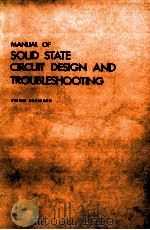
- Manual of solid state circuit design and troubleshooting
- 1977 Reston Pub. Co.
-
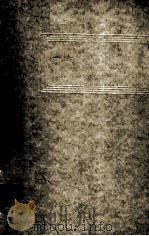
- Tumors of The Skin
- 1957 Armed Forces Institute of Pathology
-

- HANDBOOK OF PAEDIATRIC DERMATOLOGY
- 1985 BUTTERWORTHS
-

- DISEASES OF THE SKIN
- 1954 HENRY KIMPTON
-

- Cancer of the skin
- 1991 Saunders
-

- Histopathology Of The Skin
- 1961 J.B. Lippincott Company
-
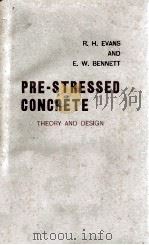
- PRE-STRESSED CONCRETE THEORY AND DESIGN
- 1958 LONDON CHAPMAN & HALL LTD
-
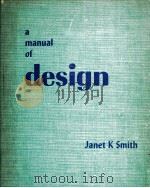
- A MANUAL OF DESIGN
- 1950 REINHOLD PUBLISHING CORPORATION
-
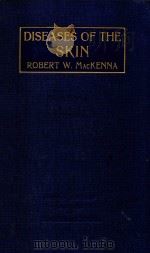
- DISEASES OF THE SKIN A MANUAL FOR STUDENTS AND PRACTITIONERS
- 1933 BAILLIERE TINDALL AND COX
-

- Atlas of Skin Cancer
- 1991 C.V. Mosby
-

- TUMORS OF THE SKIN
- 1956 CHARLES C THOMAS PUBLISHER
-

- Pseudocarcinoma of the Skin
- 1986 Consultants Bureau
提示:百度云已更名为百度网盘(百度盘),天翼云盘、微盘下载地址……暂未提供。➥ PDF文字可复制化或转WORD


